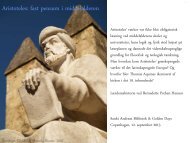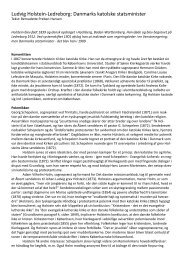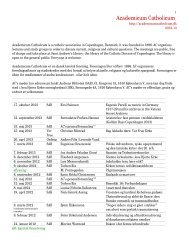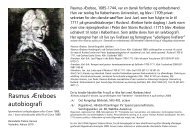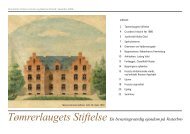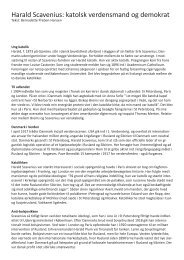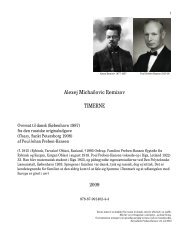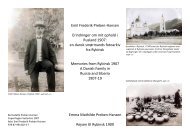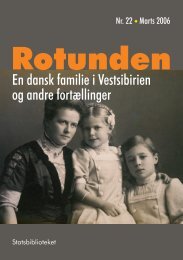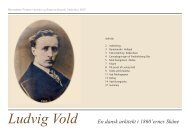Esther Aksel-Hansen - Bernadette Preben-Hansen
Esther Aksel-Hansen - Bernadette Preben-Hansen
Esther Aksel-Hansen - Bernadette Preben-Hansen
Create successful ePaper yourself
Turn your PDF publications into a flip-book with our unique Google optimized e-Paper software.
En upubliceret arbejdsudgave (en transskription in extenso) af originalbrevene<br />
(NKS 5244, 4°) er indgået på Det Kongelige Bibliotek, Center for<br />
Manuskripter og Boghistorie, København 2010: 200 sider, 640 noter på<br />
grundlag af forskning i Statens Arkiver 2005-7. Udgiver kan kontaktes for<br />
en PDF, http://preben.nl <strong>Bernadette</strong> <strong>Preben</strong>-<strong>Hansen</strong><br />
<strong>Esther</strong> <strong>Aksel</strong>-<strong>Hansen</strong> var skrivedame<br />
for Harald Scavenius,<br />
Danmarks gesandt i Rusland.<br />
Hun sad på Scavenius’ forkontor<br />
1917-18, og skrev 101 private<br />
breve hjem til sin mor. Brevene<br />
er skrevet med journalistisk flair<br />
og handler om dagligdagen i St<br />
Petersborg under den russiske<br />
revolution<br />
<strong>Esther</strong> <strong>Aksel</strong>-<strong>Hansen</strong><br />
Breve fra Petrograd<br />
1917-18<br />
Det Kongelige Bibliotek<br />
NKS 5244, 4°<br />
The Danish Embassy in St Petersburg<br />
during the Days of the Russian Revolution<br />
Letters in Danish, edited by <strong>Bernadette</strong> <strong>Preben</strong>-<strong>Hansen</strong> 2007
<strong>Esther</strong> <strong>Aksel</strong>-<strong>Hansen</strong> (1891-1963)<br />
In 1915, <strong>Esther</strong> travelled to Rybinsk, a port on the River Volga in Russia.<br />
She worked half a year as an English teacher for a Russian lawyer’s family.<br />
And she formed a friendship with a Danish family. The <strong>Preben</strong>-<strong>Hansen</strong><br />
family (three brothers being settled in Russia and Siberia as Danish butter<br />
merchants) did business in Rybinsk, Yaroslavl and in Kurgan in West<br />
Siberia, 1899-1919. In 1917, <strong>Esther</strong> was back in Copenhagen, where<br />
she taught Russian. One of her students was a secretary of the Danish<br />
Ministry of Foreign Affairs in Copenhagen. Through him, she got a job.<br />
In April 1917, <strong>Esther</strong> was appointed a typist at the Danish Embassy in St<br />
Petersburg (Petrograd 1914-24). She became attached to Section B: The<br />
Department for the Danish Safeguarding of Austria-Hungary’s Interests<br />
in Russia. And on May 6 th 1917, she travelled with the Danish legation<br />
heading towards St Petersburg. At the embassy she changed places with<br />
Isabella Smith, a typist in Section A: “the old Danish legation”.<br />
›<strong>Esther</strong> typed for Harold Scavenius. He was the Danish Ambassador<br />
in Russia from 1912-18. Working in his front office, she typed<br />
reports, kept the journal of incoming and outgoing post and packed the<br />
diplomatic bag. From May 9 th 1917 to May 19 th 1918 she sent one hundred<br />
long letters home to her mother, as well. The letters reached Copenhagen<br />
by courier for the Foreign Ministry, where they were picked up by<br />
family. The letters, gradually turning into diary entries, are written with<br />
journalistic flair. <strong>Esther</strong> writes at night telling of daily life, bread shortages,<br />
increasing famine and dying horses in the streets of St Petersburg.<br />
Against the orders of the legation, she participates in street demonstrations.<br />
She takes sleigh rides through an icy St Petersburg in the evenings,<br />
visiting the city’s railway stations at night. And she breaks the Embassy’s<br />
confidentiality, particularly on personnel matters. Occasionally she makes<br />
an extra carbon copy of a confidential embassy report and sends it with<br />
the letter to her mother.<br />
›On June 20 th 1918 <strong>Esther</strong> travelled with Isabella Smith and Wilhelm<br />
Voigt Broch from St Petersburg via Beloostrov and Tornio to Copenhagen<br />
on leave. Shortly afterwards she was dismissed. The legation was<br />
in the process of closing down. <strong>Esther</strong>’s letters are a main source for daily<br />
life at the Danish Embassy in St Petersburg 1917-18. Selected letters<br />
from 1917 have been published in Russian translation by Ludmila Weil in<br />
a literary magazine in Moscow. <strong>Bernadette</strong> <strong>Preben</strong>-<strong>Hansen</strong>



